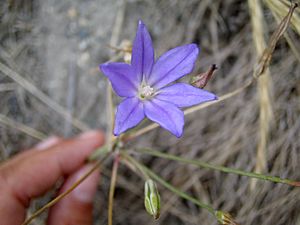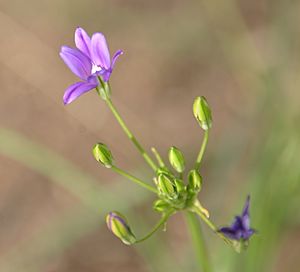Threadleaf brodiaea facts for kids
Quick facts for kids Threadleaf brodiaea |
|
|---|---|
 |
|
| Conservation status | |
| Scientific classification | |
| Synonyms | |
|
Hookera filifolia |

The Brodiaea filifolia, also known as the threadleaf brodiaea, is a special flowering plant. It's quite rare! You can only find it in southern California. Most of these plants live where Orange, Riverside, and San Diego Counties meet.
This plant grows from a bulb and likes to live in places called vernal pools and grasslands. Vernal pools are like temporary ponds that fill with water in the wet season. Because it's so rare, the United States government lists it as a threatened species. The state of California also lists it as an endangered species.
What It Looks Like
The threadleaf brodiaea is a perennial plant. This means it lives for more than two years. It grows a flower stalk that can be 20 to 30 centimeters (about 8 to 12 inches) tall.
At the top of the stalk, you'll see bright purple flowers. Each flower has six petals, called tepals, that spread out. They are about 1 to 1.5 centimeters long. In the middle of the flower, there are three stamens. These are the parts that make pollen. There are also small, flat, sterile stamens called staminodes. They lie flat against the tepals.
Why This Plant Is Rare
The threadleaf brodiaea grows in grasslands, often in areas that flood sometimes. It's also a part of the unique group of plants found in vernal pools. This plant needs heavy clay soils to grow well.
Sadly, these special habitats are becoming very rare. People are clearing the land for new homes and buildings. This is especially true as cities and towns grow bigger.
Undeveloped land near homes also faces problems. Things like non-native plants can take over. Also, activities like mowing, efforts to stop fires, and even sewage dumping hurt the plant. Grazing by livestock and off-road vehicles also damage its home.
How It Reproduces
This plant is also at risk because it has low genetic variability. This means there isn't much difference in the genes of individual plants. The threadleaf brodiaea often makes new plants by growing new corms. A corm is like a bulb. This method is a type of cloning. It creates new plants that are exactly like the parent plant. This means they don't get new combinations of genes.
When the plant does reproduce sexually, it needs pollen from other plants that are not closely related. It cannot fertilize itself. It also can't successfully reproduce with plants that are too similar to it. When populations are small and far apart, it's harder for the plants to reproduce sexually. This makes it even harder for them to survive. Sometimes, this plant can even hybridize with another plant called Brodiaea orcuttii.
About 68 groups of these plants are left. They are spread out from the San Gabriel Mountains to west-central San Diego County. Some new groups have been found, like on Camp Pendleton. But sadly, a few groups have also disappeared from their original locations.


